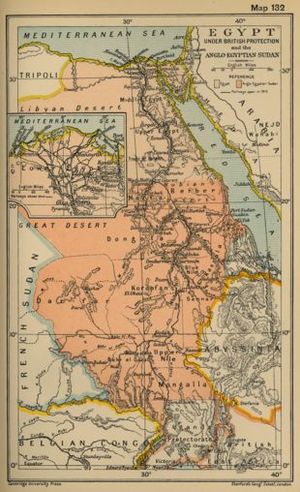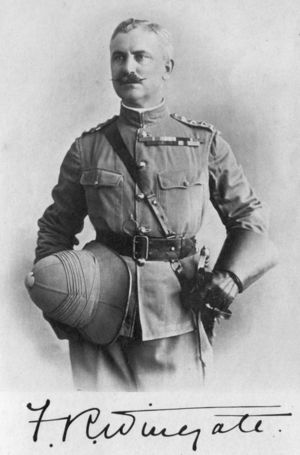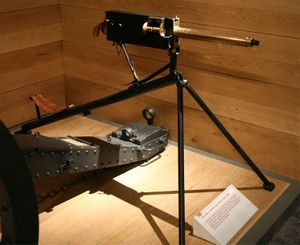التجريدة الإنگليزية المصرية على دارفور
| ||||||||||||||||||||||||||||||||||
التجريدة الإنگليزية المصرية على دارفورد Anglo-Egyptian Darfur Expedition، عام 1916، كانت عملية عسكرية قامت بها قوات من الامبراطورية البريطانية وسلطنة مصر، وقامت بغزو-وقائي دارفور. تشكلت التجريدة البريطانية والمصرية لأنهم كانوا يعتقدون أن زعيم دارفور، السلطان علي دينار، كان يستعد لغزو السودان الذي كان تحت الادارة الإنگليزية-المصرية.
القائد البريطاني للجيش المصري، سردار رجينالد ونگت، نظم قوة من حوالي 2.000 رجل، تحت قيادة ضابط بريطاني آخر، المقدم فليپ جيمس ڤاندلور كـِلي، لتولي مسئولية الحملة. في مارس 1916، أعطى ونگت أمراً لكـِلي بعبور الجبهة وبدأ الحملة.
في مايو، كانت القوات الإنگليزية المصرية قد وصلت الفاشر، عاصمة دارفور. بعدها، وقعة المعركة الحاسمة عند برينگيا، كان جيش الفور قد هزم تماماً تقريباً وإستولت القوات الإنگليزية المصرية على العاصمة في اليوم التالي. السلطان دينار كان قد غادر بالفعل قبل وصولهم دارفور، البلاد التي تشبه في مساحتها فرنسا، أصبحت مؤمنة الآن. كانت التجريدة بمثابة نجاح كامل للإنگليز-المصريين. سلطان دارفور حاول التفاوض حول شروط الإستسلام لكن البريطانيون كانوا يعتقدون أنه يماطل من أجل كسب الوقت، ولذلك فقد أوقفو المحادثات. تراجع دينار إلى الجبال، لكن في النهاية أصبح مكانه معلوماً لدى القوات الإنگليزية المصرية. أرسلت قوة صغيرة لتعقبه، وبعد إشتباك قصير قُتل دينار في المعركة في نوفمبر 1916 وأصبحت دارفور ولاية سودانية.
. . . . . . . . . . . . . . . . . . . . . . . . . . . . . . . . . . . . . . . . . . . . . . . . . . . . . . . . . . . . . . . . . . . . . . . . . . . . . . . . . . . . . . . . . . . . . . . . . . . . . . . . . . . . . . . . . . . . . . . . . . . . . . . . . . . . . . . . . . . . . . . . . . . . . . . . . . . . . . . . . . . . . . . .
خلفية
في أواخر القرن التاسع عشر وأوائل القرن العشرين دارفور، والتي تعني "أرض الفور"،[1] كانت بلد مستقل، تقع غرب السودان وشرق ما عرف فيما بعد بأفريقيا الإستوائية الفرنسية. وتساوي في مساحتها فرنسا ويمكن أن تقسم إلى ثلاث مناطق: منطقة شبه قاحلة في الشمال، حيث تتساقط كميات قليلة جداً من الأمطار، وصولاً إلى الصحراء الكبرى؛ منطقة وسطى تنقسم إلى قسمين يفصل بينهما بركان جبل ماره، والذي يصل إرتفاعه إلى 3.000 متر فوق مستوى سطح البحر وتحيط به سهول رملية وصخرية إلى الشرق والغرب؛ ومنطقة جنوبية وهي غنية بتربة طميية وأمطار سنوية غزيرة.[2]
سلطنة دارفور كانت إحدى الممالك التي تمتد عبر وسط أفريقيا. عام 1874، تعرضت للغزو من قبل جيرانها المسلمين من الجنوب، مما أدى إلى ضم البلاد من قبل مصر وأصبحت جزءاً من السودان الإنگليزي المصري. إستمر هذا حتى قيام الحرب المهدية (1881–1889)، عندما فرضت السلطات الإنگليزية المصرية قيود مؤقتة بواسطة قوات محمد أحمد، حتى عادت السيطرة الإنگليزي المصرية على المنطقة في أعقاب معركة أم درمان في 2 سبتمبر 1898. عام 1899، أصبح علي دينار سلطاناً على دارفور بموافقة السردار لورد كيتشنر، بشرط أن يدفع جزية سنوية للبريطانيين. العلاقات بين دينار والإنگليز-المصريين كانت تسير بمساعدة المفتش العام رودولف كارل فون سلاتين الذي كان على دراية بمنطقة دارفور وشعبها.[3][4]
ظل الوضع على ما هو عليه حتى بدأ النزاع ماهية الحدود الغربية المحددة لدرافور ومن الأحق "بالسيادة" على مناطقها الحدودية. كان البريطانيون يعتقدون أن التأجيل سيحل هذه النزاعات، بالترافق مع الدعاية المناهضة للحكومة، والتي ستؤدي لتغيير الموقف تجاه دينار إلى جانبهم. لم تساعد اعتقاداهم مع رفض دينار السماح لأي أوروپي بالدخول إلى دارفور.[5] تسببت السياسة الداخلية لدينار بالفوضى الداخلية بين السكان العرب الذين كانوا ضده بصفة عامة، أو في حالة قبيلة الرزيقات من جنوب غرب دارفور، والتي كانت "تعاديه علناً".[5]
عند سماع أخبار الحرب بين الامبراطورية البريطانية وتركيا، أصبح دينار أكثر جرأة وفي أبريل 1915 تخلى عن ولائه للحكومة الإنگليزية-المصرية في السودان، وأعلن أنه موالي للأتراك وعقد اتفاق معهم عن طريق السنوسيين. في ذلك الوقت، كان عدد سكان دارفور أقل من 1.000.000 نسمة يحكمهم ما يوصف "بجيش العبيد" وقوامه حوالي 10.000 رجل.[nb 2] بحلول ديسمبر، تدهورت الأوضاع إلى حد أن وحدة صغيرة من سلاح الهجانة المصري، كانت قد أرسلت لحماية التجارة في ناهود، وفي نفس الوقت تكون قوة تحذيرية ضد الهجوم المحتمل من دينار على قبيلة الرزيقات. بدلاً من التصدي لتلك القوة قام دينار بنقل قواته - 14 فارس و20 من المشاة - إلى جبل الهيلة المعزز. ومع ذلك، وبمرور الوقت إعتقد البريطانيون أنا كن يستعد لغزو السودان.[5][7]
التجريدة
لمواجهة التهديد المتوقع على السودان، السردار رجينالد ونگت حشد قوة عند ناهود. كان القائد البريطاني المقدم فليپ جيمس ڤاندلير كـِلي، من فرقة الفرسان الملكية الثالثة، على سبيل الإعارة للجيش المصري. كانت القوة تتكون من:
- سريتين من المشاة، بقيادة الميجور كوبدن، 9th Lancers؛
- Five companies from the Camel Corps, commanded by Major Huddleston, Dorsetshire Regiment;
- Six companies from the 13th and 14th Battalions, Sudanese Infantry, commanded by Major Bayly, Royal Welsh Fusiliers and Major Darwell, Royal Marine Light Infantry;
- Two companies from the Arab Battalion, commanded by Major Cowan, Cameron Highlanders;
- Two companies from the 14th Battalion, Egyptian Infantry;
- Two 12-pounder artillery batteries, which also included two Maxim machine guns, commanded by Major Spinks Royal Artillery; and
- One Maxim machine gun battery.[4][8]
برفقة وحدات طبية وأخرى غير مقاتلة، كان إجمالي القوات 2.000 رجل. أيدت المخابرات نظرية أن دينار كان سيغزو السودان، ولذا ففي مارس 1916 أمر ونگت كـِلي بعبور الحدود وإحتلال جبل الهيلة وأم شنقة. توفر القريتان مصدراً دائماً لإمدادات المياه وكانتا على الطريق إلى الفاشر، عاصمة دينار.[4][5][8]
في 16 مار، تحركت ست سرايا من the Camel Corps and mounted infantry scouts, supported by a 12-pounder artillery battery and a Maxim machine gun battery، عبرت حدود دارفور وبعد أربع أيام إحتلت أم شنقة. كان هناك معارضة وحيدة نقطة رصد صغيرة والتي أجبرت على الإنسحاب. على غير المتوقع، عند وصول القوات الإنگليزية المصرية وجدت أن مورد المياه في أن شقنة شحيح. مع توقع أن يصل القسم الأكبر من قواته في هذا المساء، وفي ظل توافر مياه تكفي ليومين فقط، إعتبر فكر كـِلي في الإنسحاب إلى السودان. بدلاً من ذلك، قسم قواته، وشكل صف متحرك سريع، يتكون من thirty mounted infantry scouts, 240 men from the Camel Corps, قطعتي مدفعية وثمانية مدافع مكسيم، والذي ترك جبل الهيلة في 22 مارس.[4][5]
جبل الهيلة
واجه صف كـِلي الطائر معارضة محدود فقط من فرق استطلاع الفور حتى وصوله موقع يبعد 6.4 كم عن جبل الهيلة. هناك قوة تضم 800 من خيالة الفور حاولة محاصرتهم، وقاموا فقط بمنعهم من فعل ذلك بإطلاق المدافع الآلية الأنگلو-مصرية. بتقدمهم 3.2 كم أخرى عثروا على تمركز كبير لقوات الفور في وادي مشجر، والتحموا معهم مستخدمين المدفعية والمدافع الآلية. بعد اجبارهم قوات الفور على التشتت، وصلت القوات جبل الهيلة في الساعة 14.15، وقامت بتأمين الآبار بدون أي معارضة أخرى. أمر كـِلي فرقة إستطلاع صغيرة بفحص الآبار عند لقد على بعد 3.2 كم، والتي تم إحتلالها بالقوة، عندما وصلت بقية قوات كـِلي في 26 مارس. أثناء تقدمهم، وصفت خسائر القوات الأنگلو-مصرية بأنها "ضئيلة" بينما كانت قوات الفور قد فقدت 20 رجل بين قتيل وجريح. بإحتلال جبل الهيلة، كان القوات الأنگلو-مصرية قد أمنت أحد الطرق المؤدية لغزو السودان.[4][5]
جيش الفور الرئيسي كان يتمركز في عاصتمتهم الفاشر وكان عدد ما بين 4.000 و6.000 رجل مع إمدادات كافية من الذخيرة.[9] كانت ذخيرتهم تتراوح ممن أسلحة muzzleloader القديمة، مثل بنادق مارتيني-هنري ورمينگتون والشوزن، إلى الرماح، الدروع والتروس.[6] كانوا مدعمين بعدد غير معروف من قوات المساعدة المسلحة بالرماح فقط. في الوقت نفسه كان دينار قد جمع قواته من المناطق الأخرى إلى العاصمة. هؤلاء في اتصالهم بالقوات الأنگلو-مصرية وبعدد محدود من التحصينات، بدلاً من ذلك تم جمعها في بوروش وقدادة.[4][9]
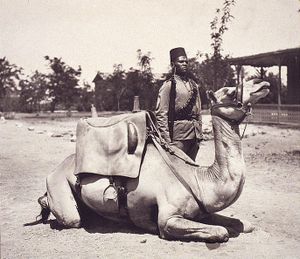
مشكلات الإمداد
اعتقد ونگت أن دينار سيتجنب خوض معركة كبيرة في الولايات، لكنه بدلاً من ذلك سيجمع قواته في الفاشر، حتى يبدأ موسم الأمطار، مما يكون في صالحهم من أجل خوض قتال بأسلوب حرب العصابات وشن الغارات على القوات الأنگلو-مصرية وخطوط اتصالاتهم. ومع ذلك، فقد كان الاهتمام الآني لكـِلي هو توفير المياه وإمدادات أخرى لقواته. تزامن وجود القوات الأنگلو-مصرية مع فترة عدم هطول الأمطار وفي حالة إستخدامهم لجميع الإمدادات الغذائية المحلية، ستكون أقرب نقطة إمداد لهم على طريق السكك الحديدة عند الأبيض على بعد 480 كم غرباً. للتغلب على بعض من مشكلات الإمداد بدأ ونگت في انشاء طريق مناسب للقاطرات، والتي كان قد حصل عليها لإستكمال نقل جماله. يمتد الطريق من خط السكك الحديدية عند رهد حتى التويشة ثم إلى العاصمة الفاشر، بطول حوالي 740 كم. عند إكتماله، ستستغرق الرحلة على الطريق بالمركبات، من خط السكك الحديدية إلى العاصمة، أربع أيام. الجنرال السير أرشيبولد مري، قائد قوة التجريدة المصرية الذي حارب في حملة سيناء وفلسطين، شكل فيلق ملكي طائر لإرسال سرب من أربع طائرات، 15-pounder guns وذخيرة، وحدات اتصالات لاسلكية، ومركبات نقل خفيفة، لمساعدة التجريدة.[4][9]
استطلاع أبريل
In early April, Anglo-Egyptian reconnaissance patrols located small numbers of Fur troops at Burush, Um Eisheishat and Um Kedda. To their south the Fur troops deployed at Taweisha were withdrawn to Tulu. Kelly ordered a large reconnaissance force to head west to Abiad. They had three objectives: locate any water supplies, for their men and animals; disperse any Fur troops at Burush and Um Kedada; and deny the Fur forces access to the water wells at Abiad and at the same time secure the route between Nahud and El Fasher.[9] On 3 April, the Anglo-Egyptian force, consisting of two mounted infantry companies, four artillery pieces, six Maxim machine guns and the 13th Sudanese Battalion companies, reached Burush by midday forcing out a Fur cavalry unit. The next day they continued their advance towards Um Kedada. This time they met a Fur force of 700 men, some entrenched in front of the wells, but the Anglo-Egyptian guns opened fire on them forcing them to withdraw. Four days later, on 8 April, the Anglo-Egyptian reconnaissance continued, reaching Abiad early the next day only to find that the Fur troops had left the previous evening. Leaving four Sudanese infantry companies and four guns behind the remaining Anglo-Egyptian reconnaissance force continued deeper into Darfur. The garrison left behind at Abiad was attacked on 14 and 15 April, but casualties are not recorded. By the end of the month the lines of communication road was secured, with large detachments of Anglo-Egyptian troops left at Abiad, Um Kedada, Burush, Lugud, Jebel el Hella and Um Shanga. At the same time a system of observation posts was established along the frontier from Gabr el Dar to Shebb manned by 260 friendly natives, who were issued with Remington rifles. Another 200 men belonging to the Kababish tribe occupied Jebel Meidob, observing the road from Darfur to the Senussi lands in the north.[9]
تقدم مايو للاتصال
In May, the Anglo-Egyptian forces started reinforcing their lines of communication and bringing forward supplies to enable them to continue the advance.[9] The Fur Army did not leave them alone and on 5 May a force of 500 men attacked the Anglo-Egyptian garrison at Abiad and four days later the telegraph post 3 miles (4.8 km) east of Abiad was also attacked. On 12 May, an RFC reconnaissance aircraft flew over El Fasher dropping leaflets to the population.[4][10] The leaflets denounced Dinar and promised that once he was removed there would be religious freedom and justice for all, and that the tribal leaders would remain in position, if they submitted and there would be an end to repression.[11]
By 14 May Kelly had completed his preparations to advance to El Fasher and had gathered a force at Abiad consisting of sixty mounted infantry scouts, four companies from the Camel Corps with two Maxim machine guns of their own, eight companies from the 13th and 14th Sudanese Infantry and the Arab Battalion. They were supported by eight artillery pieces, fourteen Maxim machine guns and a field hospital. Still suffering from a shortage of water Kelly divided the force into two columns. "A" Column would be slow moving, while "B" Column would be more mobile. They would reunite at a rendezvous point 40 miles (64 km) west of Abiad and 28 miles (45 km) from the village of Meliet, which had a well known supply of water. Reconnaissance patrols had located a small Fur garrison at Meliet and Kelly made that his first objective. Once Meliet had been captured the Anglo-Egyptians would be well positioned to attack the capital, El Fasher.[4][10]
Just after 04:00 on 15 May a small unit of mounted infantry scouts, captured a Fur observation post 2 miles (3.2 km) from Abiad, taking prisoner all bar two of the Fur soldiers who managed to escape on foot. The slow moving "A" Column left Abiad on 15 May followed by the "B" Column the next day. Both columns reached the rendezvous on 17 May. The same morning an RFC reconnaissance aircraft bombed a force of around 500 Fur troops at Meliat. The next day both of Kelly's columns reached the village, which had been evacuated by the Fur troops, leaving some of their supplies behind. On 19 May, RFC reconnaissance aircraft reported there was no trace of any Fur troops within 15 miles (24 km). However, the Anglo-Egyptian force was exhausted from their cross country march and remained resting at Meliat.[4][10]
معركة برينگيا
At 05:30 on 22 May, the Anglo-Egyptian advance continued, but the nature of the country, which consisted mainly of rolling low level sand-hills, with plenty of concealed ground and scattered bushes, reduced visibility down to just a few hundred yards. From the start, large groups of Fur camaliers and cavalry were observed. So instead of sending out his scouts Kelly formed an advance guard of the mounted infantry, a camel company and four Maxim machine guns. At 10:30, the Fur troops were observed in a strong entrenched position around the village of Beringia.[4][10]
The Fur Army commander, Ramadan Ali, had established a 2,000 yards (1,800 m) crescent shaped trench, mostly concealed from the advancing Anglo-Egyptians by a wadi. Ali's plan was for them advance close enough for him to ambush them with his trench system, believing that his larger force would overrun their artillery and machine guns before they could cause any serious damage to his troops.[12]
The Anglo-Egyptian artillery opened fire on the Fur trenches, driving the Fur troops back. To the Anglo-Egyptian left Fur horsemen were seen gathering and they were also engaged by the artillery at a range of 1,600 yards (1,500 m). The Anglo-Egyptians formed a square and advanced 800 yards (730 m), then started digging trenches of their own. At the same time, the advance guard were ordered to man a higher position to the right front and south-west of the square. To counter a threat from Fur cavalry from his left, Kelly sent a Camel Corps company and a Maxim machine gun section to secure the higher ground there.[4][10]
The Anglo-Egyptian forces were established 500 yards (460 m) from Beringia. The main Fur army position was 600 yards (550 m) south of the village, extending for 1,000 yards (910 m) to the east and west in a semi circle. Kelly's scouts could not get into a position to see all of the Fur Army positions so Kelly made the decision to launch an immediate attack. While he was organising the assault, Huddleston commanding the Camel Corps company escorting the artillery and machine guns on the right of the square, exceeded his orders and entered the village.[4][10][12] Exiting to the south they came under heavy fire from the Fur defenders and were forced to withdraw, pursued by some of the Fur troops. However, when they came within range of the Anglo-Egyptian square, their artillery and machine guns opened fire on their open flank. Seeing this, the remainder of the Fur Army left their trenches and attacked the southern side of the square in strength. The south of the square was manned from left to right by an artillery battery, three infantry companies, another artillery battery, one infantry company and a Maxim section. There was then a gap of around 150 yards (140 m) before another infantry company and a Maxim section were positioned facing east. Kelly now reinforced the south of the square with two Maxim sections and a company from the Arab Battalion. The Fur attack lasted around forty minutes, but it eventually failed and the nearest they got to the square was around 10 yards (9.1 m).[nb 3][4][10] Kelly ordered an infantry counter-attack, supported by his artillery, with the Maxim guns advancing alongside the infantry. The Fur Army broke and the survivors retreated, leaving 231 dead,[nb 4] ninety-six seriously wounded and another 1,000 less seriously wounded behind, from a force of over 3,600. Anglo-Egyptian casualties were four officers wounded, five other ranks dead and eighteen wounded. At 16:00, Kelly resumed his advance to El Fasher stopping for the night just short of the capital.[4][8]
The Fur Army were not defeated and a force of 500 cavalry and 300 infantry attacked the Anglo-Egyptian camp at 03:00 23 May. Kelly's artillery opened fire with starshells, lighting up the battleground. The attack was defeated, Fur casualties are not known, but the only Anglo Egyptian casualty was a wounded gunner. Later that day, at 06:00 the Anglo-Egyptians were just about to break camp, when several hundred Fur troops appeared on their left flank. They were engaged and forced to withdraw by artillery, machine gun fire and aerial bombardment. At 10:00, Kelly and his mounted troops entered the capital, finding it deserted except for some women. Sultan Ali Dinar had left El Fasher accompanied by 2,000 troops after hearing about the defeat at Beringia. Captured in the city were four artillery pieces, 55,000 rounds of small arms ammunition and 4,000 rifles.[4][8]
. . . . . . . . . . . . . . . . . . . . . . . . . . . . . . . . . . . . . . . . . . . . . . . . . . . . . . . . . . . . . . . . . . . . . . . . . . . . . . . . . . . . . . . . . . . . . . . . . . . . . . . . . . . . . . . . . . . . . . . . . . . . . . . . . . . . . . . . . . . . . . . . . . . . . . . . . . . . . . . . . . . . . . . .
ديبيس وكولمه
السلطان علي دينار، فر إلى جبال جبل مرة على بعد 80 كم جنوب-غرب الفاشر، بصحبة حوالي 2.000 رجل،[nb 5] لم تكن قوات كـِلي قادرة على تعقبه على الفور، بسبب الإرهاق وعدم وجود إمدادات. ومع ذلك، فقد قبل دينار العرض الأنگلو-مصري بالتفاوض حول شروط الإستسلام. استمرت المفاوضات حتى 1 أغسطس، عندم أوقفها كـِلي، لإعتقاده أن دينار كان يراوغ من أجل كسب الوقت. بدأ أتباع دينار بالتخلي عنه وعند هذه النقطة فقط تركه حوالي 1.000 رجل. قوات كـِلي عند هذه المرحلة كانت قد احتلت قبقبية على بعد 130 كم غرب الفاشر. هدلستون، وقوات الهجانة المرافقين له ورجال من كتيبة 13 مشاة السودانية، قطعتي مدفعية وأربع مدافع مكسيم - 200 رجل - تم إرسالهم لاحتلال ديبيس على بعد 180 كم جنوب-غرب الفاشر. وصلوا ديبيس في 13 أكتوبر، واشتبكوا مع قوات الفور والتي كانت تتألف من 150 رجل مسلح بالبنادق و1.000 رجل مسلح بالرماح، وهزموهم بعد قتال قصير. في أعقاب ذلك، بدأ دينار مرة أخرى التفاوض مع الأنگلو-مصريين. وعندما اتضح أن دينار كان يرواغ فقط، أرسل كــِلي 100 رجل من كتيبة 13 مشاة المشاة السودانية لتعزيز هودلستون.[4]
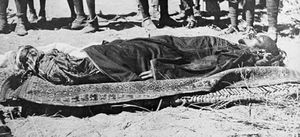
اكتشف هودلستون أن دينار كان مختبئاً في كولمه على بعد 80 كم غرباً. ما تبقى من قوات الفور كانوا في حالة مذرية، الجوع والأمراض وكان يتوقع منهم مقاومة محدةد لقوات هودلستون. بدون إنتظار التعزيزات تحرك هودلستون إلى كولمه. باحتلال القرية بدون مقاومة تذكر في 3 نوفمبر، أسروا المئات وإستولوا على معظم المخازن العسكرية المتبقية لدى دينار. بعض من أفراد عائلته استسلموا على الفور.[4]
دينار، متجنباً معركة، فرد إلى جبل جوبا إلى الجنوب الغربي من كولمه. بعد يومين، في 5 نوفمبر، هودلستون برفقة 150 رجل، قطعة مدفعية وأربع مدافع مكسيم، على الخيل التي تم الإستيلاء عليها، انطلقت لتعقبه. وصل هودلستون معسكر دينار في 6 نوفمبر وفتح النيران على مدى 460 من مخيم الفور. عثرت قوات هودلستون على جثمان دينار وقد أطلق عليه الرصاص في الرأس.[4]
النتائج
بعد التجريدة، أصبحت دارفور المستقلة، وسكانها، جزءاً من السودان.[4] فاتورة بقيمة 500.000 جنيه إسترليني قيمة التجريدة أرسلت إلى الحكومة المصرية في القاهرة لدفعها من قبل دافعي الضرائب المصريين.[14] كذلك تم تكريم القادة البريطانيين في التجريدة. عام 1917، أصبح ونگت مفوض بريطاني رفيع المستوى في مصر.[15] قائد التجريدة الأنگلو-مصرية، كـِلي، أصبح أول حاكم لولاية دارفور وكان مكتبه يقع في حجرة العرش بقصر السلطان حتى مايو 1917.[16] بعدها تم ترقيته لرتبة عميد ومُنح قيادة 5th Mounted Brigade، والذي كان جزءاً من Australian Mounted Division الذي يحارب في فلسطين.[17][18]
المصادر
- الهوامش
- ^ These are the only casualties recorded, the true amount could be greater.
- ^ عام 1903، تشكل جيش الفور من ما يقارب 1.700 فارس و6.000 من المشاة مقسمين إلى فرق، لكن في تقرير أعد قبل فترة قصيرة من التجريدة ورد أن العدد إنخفض إلى 5.000 رجل.[6]
- ^ MacGregor claims there attack had got within 6 yards (5.5 m).[12]
- ^ Daly gives the number of dead as 261.[13]
- ^ Daly claims he fled accompanied only by a "small retinue".[13]
- المصادر
- ^ "Q&A: Sudan's Darfur conflict". BBC News. Retrieved 10 September 2013.
- ^ "Darfur: Land, People, and Conflict". Darfur Development. Retrieved 8 September 2013.
- ^ "No. 29800". The London Gazette. 24 October 1916. London Gazette uses unsupported parameters (help)
- ^ أ ب ت ث ج ح خ د ذ ر ز س ش ص ض ط ظ ع غ ف McMunn and Falls, pp.147–153
- ^ أ ب ت ث ج ح "No. 29800". The London Gazette. 24 October 1916. London Gazette uses unsupported parameters (help)
- ^ أ ب Daly, p.107
- ^ Daly, p.111
- ^ أ ب ت ث "No. 29800". The London Gazette. 24 October 1916. London Gazette uses unsupported parameters (help)
- ^ أ ب ت ث ج ح "No. 29800". The London Gazette. 24 October 1916. London Gazette uses unsupported parameters (help)
- ^ أ ب ت ث ج ح خ "No. 29800". The London Gazette. 24 October 1916. London Gazette uses unsupported parameters (help)
- ^ Daly, p.112
- ^ أ ب ت McGregor, p.213
- ^ أ ب Daly, p.113
- ^ MacGregor, p.215
- ^ "Previous Ambassadors". British Embassy Cairo. 2 January 2013. Retrieved 10 September 2013.
- ^ Daly, p.118
- ^ "Papers of Brigadier General Philip Kelly". National Archives. Retrieved 10 September 2013.
- ^ Preston, p.333
- المراجع
- Daly, Martin William (2010). Darfur's Sorrow: The Forgotten History of a Humanitarian Disaster. Cambridge, England: Cambridge University Press. ISBN 1139788493.
- MacGregor, Andrew James (2006). A Military History of Modern Egypt: From the Ottoman Conquest to the Ramadan War. Praeger Security International. Westport, Connecticut: Greenwood Publishing Group. ISBN 0275986012.
- MacMunn, Sir George Fletcher; Falls, Cyril (1928). Military Operations, Egypt & Palestine: From the Outbreak of War with Germany to June 1917. Official History of the Great War Based on Official Documents by Direction of the Historical Section of the Committee of Imperial Defence. Vol. Volume 1. London: H.M. Stationery Office. OCLC 817051831.
{{cite book}}:|volume=has extra text (help) - Preston, Richard Martin (1921). The Desert Mounted Corps: An Account of the Cavalry Operations in Palestine and Syria, 1917–1918. London: Constable and Company. ISBN 9781146758833.

